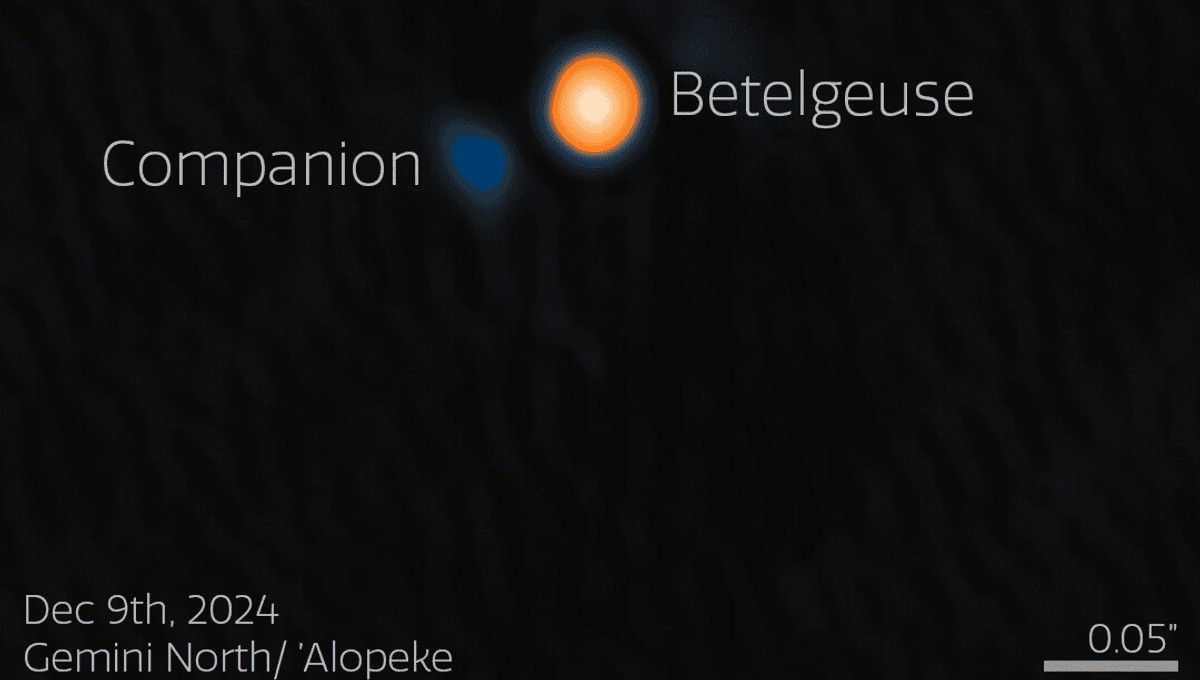It Looks Like We’ve Found Betel-Buddy, Betelgeuse’s Suspected Companion Star

It Looks Like We’ve Found Betel-Buddy, Betelgeuse’s Suspected Companion Star
The suspicion that some of Betelgeuse’s odd behavior is caused by a close companion star appears to have been confirmed using observations from the Gemini North telescope. It’s taken one of the world’s largest instruments to find something that, were it not for being outshone by the red supergiant, would be visible with binoculars.
Betelgeuse’s deep red color and its location on the shoulder of Orion make it one of the first stars anyone learns as they familiarize themselves with the sky. Its changes in brightness (and possibly color) have also attracted plenty of attention, working their way into Indigenous Australian stories long before the invention of the telescope. Today, however, it is perhaps best known as the nearest supernova candidate, even if most research now indicates that’s at least 100,000 years off. Interest in Betelgeuse intensified during its great dimming in 2019-20 and subsequent resurrection. Among several explanations offered for the event was the possibility that a companion star, quickly nicknamed Betel-buddy, could be driving a six-year cycle in brightness. Now it seems the culprit has been found. A team led by Dr Steve Howell of the NASA Ames Research Centre used the ‘Alopeke speckle imager on the Gemini North telescope to minimize distortions caused by Earth’s atmosphere. Observations made in 2024 reveal a star located 52 milliarcseconds from Betelgeuse. The fact the star couldn’t be seen by the same instrument in 2020 but was visible in 2024 indicates it’s in orbit around the supergiant star, and frequently hidden, rather than a more distant object that happens to lie in the same line of sight. A paper reporting the finding acknowledges the detection lacks the confidence usually required for astronomical discoveries to be considered proven (1.5σ when 3 or 5 are usually considered the bar). However, it adds, “The results are in reasonable agreement with the predictions,” in terms of mass, brightness and location and distance relative to Betelgeuse. The star has a magnitude of 8.5, which is beyond the range of visibility to the human eye, but detectable with small instruments when not overwhelmed by the brightness of a nearby object. Betel-buddy is thought to be 1.6 times as massive and 9 times as luminous as the Sun – it’s certainly no insignificant red dwarf, as some had theorized. However, massive stars evolve much faster than even medium-sized ones. Betelgeuse (with around 18 solar masses) has gone through most of its life-cycle before Betel-buddy, which is likely the same age, has probably even started hydrogen fusing, instead getting its heat from gravitational contraction. The distance between the two stars is thought to be about 4 AU (four-fifths the distance from Jupiter to the Sun). We've seeeeen things you wouldn't believe; a companion star glinting off the shoulder of Orion. The image was taken with a tight color filter and then artificially colored based on the discoverers' guess of its color. Image credit: International Gemini Observatory/NOIRLab/NSF/AURA; image processing: M. Zamani (NSF NOIRLab) If confirmed, the find will be important not just for Betelgeuse, but for our knowledge of red supergiants in general. Companion stars have been proposed as the cause for variability cycles for other aging supergiants, including for Eta Carinae, but this is the first time one has been detected at such close range. In fact, Betelgeuse is so large that Betel-buddy orbits within its extended atmosphere. “Gemini North’s ability to obtain high angular resolutions and sharp contrasts allowed the companion of Betelgeuse to be directly detected,” Howell said in a statement. He added, “Papers that predicted Betelgeuse’s companion believed that no one would likely ever be able to image it.” The name Betel-buddy may be misleading however, as the smaller star looks more like prey than friend. Passing through Betelgeuse’s outer atmosphere creates friction, which must be causing the star to spiral inwards. It’s remarkable that we have developed telescopes at almost the last opportunity to see the doomed star, since it is expected to dissolve into the supergiant within 10,000 years. Instead of being a survivor of a future Betelgeuse supernova explosion, Betel-buddy will supply a little bit of extra fuel. Poor Betel-buddy, eaten by its neighbor before it got to live as a star. Perhaps in recognition of that, the authors propose a new name, Siwarha, instead, which means “Her Bracelet”, recognizing that Betelgeuse in Arabic means “Hand of the Giant”. Although the Great Dimming involved a large cloud of dust being expelled by Betelgeuse, and blocking our view of the enormous star, it also coincided with several different length brightness cycles bottoming out together. The best known of these cycles runs for around 416 days, but a secondary cycle has a 2,170-day (5.95-year) period. It’s common for red giants to pulse as they near the end of their lives, so the 416-day cycle is not unusual, but the secondary period needed more explanation. Last year two teams independently proposed that cycle could be caused by a low mass companion, whose officially name α Ori B no one was likely to use. Efforts to find Betel-buddy in UV light with the Hubble Space Telescope were inconclusive, but one paper undergoing peer review used them to place limits on its size. “This detection was at the very extremes of what can be accomplished with Gemini in terms of high-angular resolution imaging, and it worked. This now opens the door for other observational pursuits of a similar nature,” Howell said. The twin stars are currently too close to each other in the sky for even Gemini North to distinguish them, as one passes almost behind the other. Our next opportunity to see them at maximum separation will be in November 2027. The study is published open access in the Astrophysical Journal Letters.


